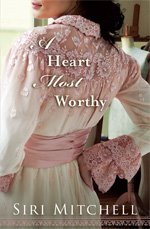A two-time Christy Award nominee, Siri Mitchell is known for bringing history to life in a way few authors can. Never one to mildly set a story in the past, Siri embraces the full culture and practices of the time—offering an accessible, accurate, and entertaining picture of days gone by. Her skill, engaging style, and compelling storytelling have caused readers and critics alike to take notice.
In A Heart Most Worthy
, Siri delves into the fascinating Italian immigrant experience during WWI through the lives of three very different women. But as the women’s lives—and secrets—intertwine, will America prove to be a place where dreams come true, or will they ruin their chances of happiness forever?
Can you provide a brief description of your latest release?
This book submerses the reader in the Italian immigrant experience. What did those immigrants contribute to American culture?
What didn’t they contribute—from food to language to culture? Who doesn’t like pasta? Who has never ordered a pizza or said ‘caio’ or hummed a tune of Frank Sinatra’s? The ice cream cone, the concept of the shopping mall, and the Lincoln Memorial owe their creation to Italian Americans. The name of our country was taken from an Italian, Amerigo Vespucci. On a broader scale, Italian vegetables like zucchini and broccoli were all but unknown in America before the Great Emigration began in 1880. It’s unfortunate that quite often Americans equate Italian culture with the mafia, but that percentage of immigrants was very slight.
I’ve never heard of The Great Emigration before. What was that?
The Great Italian Emigration to America began in 1880 and ended in 1921. Historians estimate that 4.2 million people left Italy to settle in the United States. Entire Italian towns were left emptied. Though the vast majority of Italians came in peace with no thought but to settle and begin their lives anew, Americans, alarmed at their vast numbers and horrified at their odd customs, reacted with xenophobia and fear. The only other race more frequently lynched during the time period were African Americans. Along with the peaceful immigrants, however, came anarchists. Long before the Twin Towers in New York City were ever built, early 20th century anarchists had determined that their most powerful weapon was the bomb, their most expendable asset, themselves. Like modern suicide bombers, a surprising number of anarchists blew themselves up in the process of dispatching their brand of violence. Anarchists terrified America in the early decades of the last century, mailing package bombs, distributing pamphlets with dire warnings, and lacing food with poison. ‘Italian’ swiftly became synonymous with Anarchist. The vast majority of honest, peaceful immigrants soon became viewed as radical zealots. To deal with the immigrant problem, Congress voted, in 1921, to set permanent quotas on immigration from certain undesirable countries. On the foundation provided by this law, the barriers to Jewish immigration during World War II were erected. With the bill’s passing, The Great Italian Emigration came to an end.
It’s relevant because we still have an immigrant problem in America. Every new immigrant population that comes to our country faces the same prejudices and xenophobia that the Italians did back then. And on a broader scale, women still have trouble believing it’s okay to be themselves, to want what they want, and be who they are. As long as people fear those who look or act differently, as long as we convince ourselves that ‘good’ or ‘nice’ people have to look or sound a certain way, then I believe that we are doomed to repeat history’s mistakes. If, however, we can remember that the God who created the desert also created the rain forest, if we recall that He created the smallest of frogs and the largest of elephants, if we can revel in our differences instead of trying to make everything conform to our own shape and size, I think we can begin to leave the mistakes of the past behind.
The year in which your novel is set was the year of the Spanish Influenza Epidemic. Why did it kill so many people?
That’s the million-dollar question! The Spanish influenza killed ten times as many Americans as World War I. It did not originate in Spain and it may not even have been influenza, but it was a pandemic, the likes of which had never been witnessed before. It first appeared in the spring of 1918. Hitching a ride on the troop transports that circulated between America and Europe, it resurfaced in the fall, seeming to appear everywhere at once. After its third wave in the spring of 1919, it retreated from whence it had come, never to be seen again. Scientists have still not been able to identify its particular strain. The Spanish influenza killed an estimated 20 – 50 million people worldwide and infected an incredible 500 million. It ambushed its victims, often felling them in the course of hours. It shredded the lungs, quite literally drowning people to death. It hit those living in close, cramped conditions, like the immigrants in the North End of Boston, especially hard. When it didn’t kill people, it left them so drained of energy that some families died simply because they had no access to food and water and none of them had the strength or consciousness to go get any. After having researched this book, I’m a big believer in the flu vaccine!


